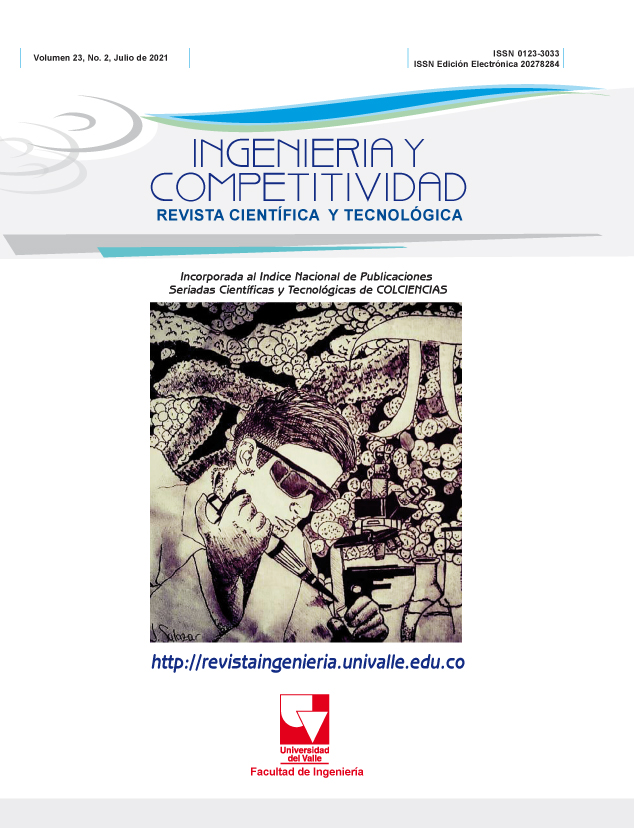Análisis molecular de hongos antagonistas aislados de plantaciones de cacao (Theobroma cacao) de Norte de Santander
Contenido principal del artículo
Las técnicas de biología molecular se han utilizado con el fin de obtener marcadores genéticos especie específicos, encontrar diferencias polimórficas y proporcionar la información necesaria para la identificación de secuencias nucleotídicas relacionadas con factores de patogenicidad en especies relacionadas con el control biológico. En la actualidad el control biológico se considera indispensable en las estrategias de agricultura sostenible con base agroecológica en los cultivos interés creciente en Colombia como el cacao (Theobroma cacao L.). Analizar molecularmente diferentes cepas de hongos antagonistas con potencial biotecnológico con el fin de dilucidar similitudes genómicas y la búsqueda de fragmentos de ADN relacionados con factores de patogenicidad. Se estandarizó la técnica de RAPDs, mediante el uso de 10 iniciadores, así mismo se amplificó el gen pr1 mediante la técnica de PCR usando 6 pares de iniciadores. Se logró una clasificación inicial de la población de hongos antagonistas y así mismo se demostró la diversidad de los aislados. Además, se logró amplificar tres genes de las cepas Beauveria bassiana, Trichoderma yunnanense y Purpureocillium lilacinus, que resultaron codificar para una familia de proteasas destinadas a ejercer actividad antagonista contra un amplio rango de hospederos. Se pudo inferir que las cepas en estudio son buenos candidatos iniciales para formulación de biopreparados destinados al control biológico de organismos plaga en cultivos de interés agrícola en la región, debido a que se encontraron rasgos y genes que permitirán ejercer una amplia acción antagónica.
- Antagonista
- biotecnología
- diversidad genética
- PCR
- RAPD
(1) FEDECACAO. Economía Nacional [Internet]. 2019. Available from: https://www.fedecacao.com.co/portal/index.php/es/2015-02-12-17-20-59/nacionales.
(2) Evans HC. Cacao diseases - the trilogy revisited. Phytopathology. 2007;97(12):1640-1643. https://doi.org/10.1094/PHYTO-97-12-1640.
(3) Alves S. Hongos entomopatógenos. In: Alves S, editor. Control microbiano de insectos. Piracicaba: FEALQ; 1998. p. 289–381.
(4) Suarez L, Rangel A. Aislamiento de microorganismos para control biológico de Moniliophthora roreri. Acta Agronómica. 2013;62(4):370–378. Available from: https://revistas.unal.edu.co/index.php/acta_agronomica/article/view/36211.
(5) Suarez L, Cabrales CP. Identificación de especies de cepas nativas de Trichoderma sp., y Bacillus sp., y evaluación de su potencial antagonista in vitro frente al hongo patógeno nativo Moniliophthora roreri de la región nororiental en el departamento Norte de Santander. Respuestas. 2008;13(1):45-56.
(6) Suarez L. Aislamiento e identificación de Moniliophthora roreri causante de la moniliasis en municipios del nororiente colombiano y ensayos preliminares para su control biológico. Respuestas. 2006;11(1):3-9.
(7) Zambrano-Bullones K, Dávila M, Castillo M. Detección de fragmentos de ADN de hongos y su posible relación con la síntesis de proteínas de actividad entomopatógena. Revista de la Facultad de Agronomía. 2002;19(3):185-193.
(8) Súarez-contreras LY. Extracción y purificación del ADN de Moniliophthora roreri hongo que ataca el cacao, en norte de Santander. Respuestas. 2016;10(2):4-8.
(9) Dávila, Martha, Zambrano, Karla, Castillo, Miguel A., Uso de la técnica RAPD para la identificación de fragmentos de ADN posiblemente relacionados con virulencia en hongos entomopatógenos. Bioagro [Internet]. 2001;13(3):93-98.
(10) Rosas-García NM. Avalos-de-León O, Villegas-Mendoza JM, Mireles-Martínez M, E, Barboza-Corona JE, et. al. Correlation between pr1 and pr2 Gene Content and Virulence in Metarhizium anisopliae Strains. Journal of Microbiology and Biotechnology. 2014;24(11): 1495-1502. https://doi.org/10.4014/jmb.1404.04044.
(11) Avalos-de León O. Identificación y análisis de los genes productores de proteasas tipo subtilisina y tipo tripsina en el hongo Metarhizium anisopliae, como factores de virulencia para su aplicación en el control biológico de insectos plaga [Master’s Thesis]. Reynosa: Centro de Biotecnología genómica. 2011.
(12) Sambrook J, Russell DW. Molecular Cloning A Laboratory Manual. 3rd ed. New York: CSHL Press; 2001. 2344 p.
(13) Vega-Contreras NA, Galvis-Serrano NF, Salazar-Mercado SA. Relaciones evolutivas de los peces Prochilodus reticulatus y Prochilodus magdalenae (Characiformes: Prochilodontidae).
Revista de ciencias. 2017;21(1):163-173. https://doi.org/10.25100/rc.v21i1.6348.
(14) Gwanama C, Labuschagne M, Botha AM. Analysis of genetic variation in Cucurbita moschata by random amplified. Euphytica. 2000;113:19–24. https://doi.org/10.1023/A:1003936019095
(15) Latha J, Mukherjee P. PCR fingerprinting of some Trichoderma isolates from two Indian type culture collections a need for re-identification of these economically important fungi. Current Science. 2002;83(4):372-375. Available from: https://www.jstor.org/stable/24106834.
(16) Góes L, Lima-Da-Costa A, López-De-Carvalho-Freire L, Tinti-De-Oliveira N. Randomly Amplified Polymorphic DNA of Trichoderma isolates and antagonism against Rhizoctonia solani. Brazilian Archives of Biology and Technology. 2002;45(2):151-160. https://doi.org/10.1590/S1516-89132002000200005.
(17) Bagga S, Hu G, Screen S, Leger RJ. Reconstructing the diversification of subtilisins in the pathogenic fungus Metarhizium anisopliae. Gene. 2004;324:159-169. https://doi.org/10.1016/j.gene.2003.09.031
(18) Hernandez-Lauzardo AN, Bautista-Baños S, Velázquez-del Valle G, Hernández-Rodríguez A. Uso de Microorganismos Antagonistas en el Control de Enfermedades Postcosecha en Frutos. Revista mexicana de patologia. 2007;25(1):66-74.
(19) Cano MA. Interacción De Microorganismos Benéficos En Plantas: Micorrizas, Trichoderma spp. y Pseudomonas spp. Revista U.D.C.A Actualidad & Divulgación Científica. 2011;14(2):15-31. https://doi.org/10.31910/rudca.v14.n2.2011.771.
(20) Fernández-Larrea OV. Microorganismos antagonistas para el control Fitosanitario. Avances en el Fomento de Productos Fitosanitarios No-sintéticos. 2001;62:96-100.
(21) Freimoser FM, Screen S, Bagga S, Hu G, Leger RJ. Expressed sequence tag (EST)
analysis of two subspecies of Metarhizium anisopliae reveals a plethora of secreted proteins with potential activity in insect host. Microbiology. 2003;149(Pt 1):239-47. https://doi.org/10.1099/mic.0.25761-0.
(22) Charnley A. Fungal pathogens of insects: cuticle degrading enzymes and toxins. Advances in Botanical. 2003;40:241-321. https://doi.org/10.1016/S0065-2296(05)40006-3.
Descargas

Esta obra está bajo una licencia internacional Creative Commons Atribución-NoComercial-CompartirIgual 4.0.
Los autores que publican en esta revista están de acuerdo con los siguientes términos:
Los autores ceden los derechos patrimoniales a la revista y a la Universidad del Valle sobre los manuscritos aceptados, pero podrán hacer los reusos que consideren pertinentes por motivos profesionales, educativos, académicos o científicos, de acuerdo con los términos de la licencia que otorga la revista a todos sus artículos.
Los artículos serán publicados bajo la licencia Creative Commons 4.0 BY-NC-SA (de atribución, no comercial, sin obras derivadas).





